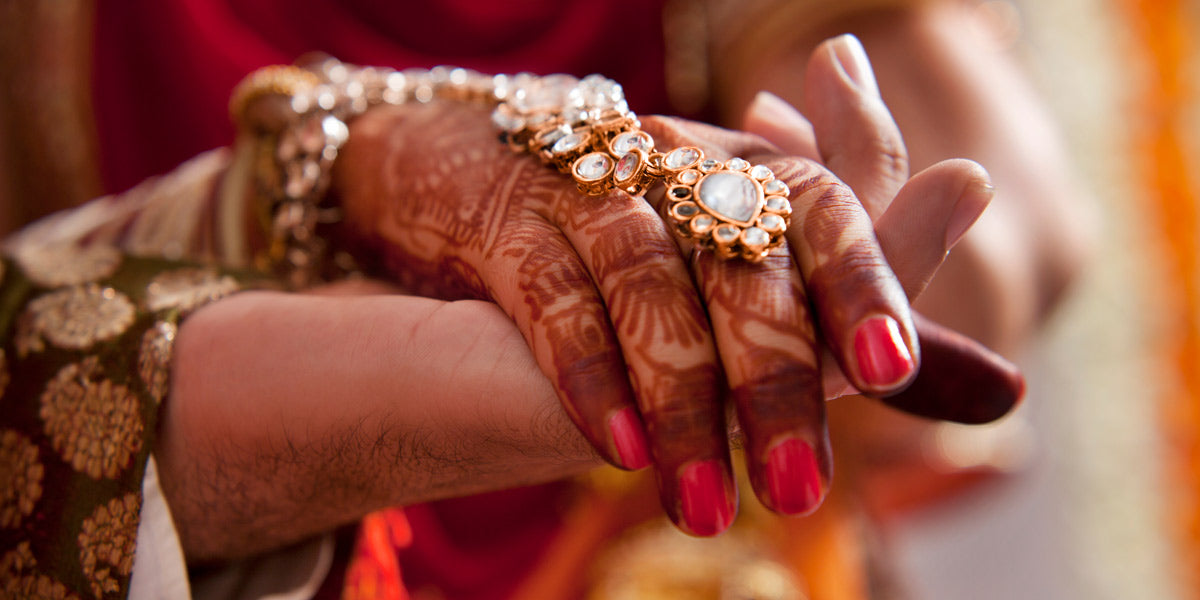
India’s colorful and opulent weddings have long been an intrinsic aspect of its culture. Thanks to India’s visible diaspora, the Big Fat Indian Wedding has caught the world’s fancy. The grand traditions of an Indian wedding are still practiced by Indian families all over the globe!
Attendees of an Indian wedding may have observed some of the event’s more grandiose characteristics; multiple-page invitations, a mind-blogging number of guests, and lavish feasting. However, a quick look at the traditional Hindu wedding ceremony reveals a few basic rites that are common to all communities.
Traditional Wedding Rituals
Most pre and post-wedding rituals are social events. With a vast majority of Indian marriages arranged by families, these occasions are tailor-made for the two extended families to bond with each other. It is also a chance for the bride and groom to familiarize themselves with their in-laws. This can be an exhausting business, but one filled with much bonhomie!
Many Indian wedding events are rooted in a time when people knew each other closely in a small, village-style community. As a result, everyone had to be invited! As different communities prospered, more events were added on to the basic ceremony as visible markers of social prestige. What was initially a community event has since spawned a veritable industry, involving wedding clothes, jewelry, beauty care, gifts, food and specialized décor.
Pre-Wedding Ceremonies
The sangeet ceremony, held days before the main function in North Indian weddings, is an occasion for both families (and friends!) to meet informally in the bride’s home. In addition to the sangeet, there’s also the haldi. Here, the bride and groom use turmeric and other traditional ingredients in a special cleansing and beautification ritual. There’s also the mehndi ceremony, an all-women affair. For this event, the bride invites all her female relatives to partake in the application of henna designs. Special songs are sung for the occasion, with much playful teasing of the bride. All of these events are lively occasions with music, singing, feasting, and a great deal of merriment.
Even the moments leading up the wedding ceremony are their own special ritual. Here, the bridegroom is welcomed to the wedding venue in grand style. Perhaps the most prominent example of this is the baraat. Practiced in Northwestern India, the baraat is the groom’s ceremonial procession made on horseback. Making his way to the wedding venue, there is often a band in attendance. Meanwhile, the baraatis (groom’s relatives) tag along and dance in abandon.
The Wedding Ceremony
The actual marriage ceremony of an Indian wedding is imbued with deep meaning. It is meant to impress upon the bridal couple the sanctity and social significance of their union. At the start, the bride is given away by her father in the Kanyadaan ritual. Then, the priest invokes Lord Ganesha, the god of auspicious beginnings and remover of obstacles. With the fire god, Angi, as a sacred witness, the priest then chants Sanskrit mantras. After this comes the Saptapadi, the seven steps made around the sacred fire. These seven steps, taken by both the bride and the groom, signify the couple’s commitments to each other. The steps stand for friendship, love, fidelity, shared duties, the begetting of children, and remaining as one for the rest of their lives. These vows are undertaken through a series of symbolic utterances, poetic in expression.
After The Wedding
Wedding receptions (honeymoons, too!) were probably a custom adopted from Christian and colonial traditions. Contemporary receptions are an occasion to invite business associates and buddies, perhaps serve liquor (prohibited during the formal ceremony), dance, and have a good time!
Attendees of an Indian wedding may have observed some of the event’s more grandiose characteristics; multiple-page invitations, a mind-blogging number of guests, and lavish feasting. However, a quick look at the traditional Hindu wedding ceremony reveals a few basic rites that are common to all communities.
Traditional Wedding Rituals
Most pre and post-wedding rituals are social events. With a vast majority of Indian marriages arranged by families, these occasions are tailor-made for the two extended families to bond with each other. It is also a chance for the bride and groom to familiarize themselves with their in-laws. This can be an exhausting business, but one filled with much bonhomie!
Many Indian wedding events are rooted in a time when people knew each other closely in a small, village-style community. As a result, everyone had to be invited! As different communities prospered, more events were added on to the basic ceremony as visible markers of social prestige. What was initially a community event has since spawned a veritable industry, involving wedding clothes, jewelry, beauty care, gifts, food and specialized décor.
Pre-Wedding Ceremonies

The sangeet ceremony, held days before the main function in North Indian weddings, is an occasion for both families (and friends!) to meet informally in the bride’s home. In addition to the sangeet, there’s also the haldi. Here, the bride and groom use turmeric and other traditional ingredients in a special cleansing and beautification ritual. There’s also the mehndi ceremony, an all-women affair. For this event, the bride invites all her female relatives to partake in the application of henna designs. Special songs are sung for the occasion, with much playful teasing of the bride. All of these events are lively occasions with music, singing, feasting, and a great deal of merriment.
Even the moments leading up the wedding ceremony are their own special ritual. Here, the bridegroom is welcomed to the wedding venue in grand style. Perhaps the most prominent example of this is the baraat. Practiced in Northwestern India, the baraat is the groom’s ceremonial procession made on horseback. Making his way to the wedding venue, there is often a band in attendance. Meanwhile, the baraatis (groom’s relatives) tag along and dance in abandon.
The Wedding Ceremony
The actual marriage ceremony of an Indian wedding is imbued with deep meaning. It is meant to impress upon the bridal couple the sanctity and social significance of their union. At the start, the bride is given away by her father in the Kanyadaan ritual. Then, the priest invokes Lord Ganesha, the god of auspicious beginnings and remover of obstacles. With the fire god, Angi, as a sacred witness, the priest then chants Sanskrit mantras. After this comes the Saptapadi, the seven steps made around the sacred fire. These seven steps, taken by both the bride and the groom, signify the couple’s commitments to each other. The steps stand for friendship, love, fidelity, shared duties, the begetting of children, and remaining as one for the rest of their lives. These vows are undertaken through a series of symbolic utterances, poetic in expression.
After The Wedding
Wedding receptions (honeymoons, too!) were probably a custom adopted from Christian and colonial traditions. Contemporary receptions are an occasion to invite business associates and buddies, perhaps serve liquor (prohibited during the formal ceremony), dance, and have a good time!


